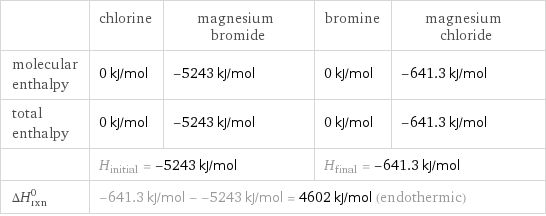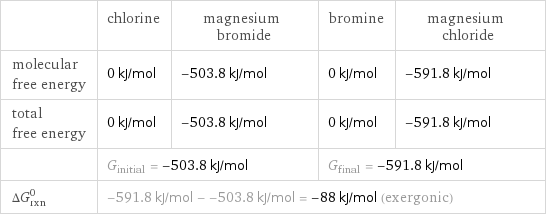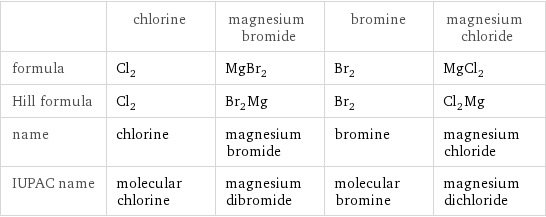Input interpretation

Cl_2 chlorine + MgBr_2 magnesium bromide ⟶ Br_2 bromine + MgCl_2 magnesium chloride
Balanced equation

Balance the chemical equation algebraically: Cl_2 + MgBr_2 ⟶ Br_2 + MgCl_2 Add stoichiometric coefficients, c_i, to the reactants and products: c_1 Cl_2 + c_2 MgBr_2 ⟶ c_3 Br_2 + c_4 MgCl_2 Set the number of atoms in the reactants equal to the number of atoms in the products for Cl, Br and Mg: Cl: | 2 c_1 = 2 c_4 Br: | 2 c_2 = 2 c_3 Mg: | c_2 = c_4 Since the coefficients are relative quantities and underdetermined, choose a coefficient to set arbitrarily. To keep the coefficients small, the arbitrary value is ordinarily one. For instance, set c_1 = 1 and solve the system of equations for the remaining coefficients: c_1 = 1 c_2 = 1 c_3 = 1 c_4 = 1 Substitute the coefficients into the chemical reaction to obtain the balanced equation: Answer: | | Cl_2 + MgBr_2 ⟶ Br_2 + MgCl_2
Structures

+ ⟶ +
Names

chlorine + magnesium bromide ⟶ bromine + magnesium chloride
Reaction thermodynamics
Enthalpy

| chlorine | magnesium bromide | bromine | magnesium chloride molecular enthalpy | 0 kJ/mol | -5243 kJ/mol | 0 kJ/mol | -641.3 kJ/mol total enthalpy | 0 kJ/mol | -5243 kJ/mol | 0 kJ/mol | -641.3 kJ/mol | H_initial = -5243 kJ/mol | | H_final = -641.3 kJ/mol | ΔH_rxn^0 | -641.3 kJ/mol - -5243 kJ/mol = 4602 kJ/mol (endothermic) | | |
Gibbs free energy

| chlorine | magnesium bromide | bromine | magnesium chloride molecular free energy | 0 kJ/mol | -503.8 kJ/mol | 0 kJ/mol | -591.8 kJ/mol total free energy | 0 kJ/mol | -503.8 kJ/mol | 0 kJ/mol | -591.8 kJ/mol | G_initial = -503.8 kJ/mol | | G_final = -591.8 kJ/mol | ΔG_rxn^0 | -591.8 kJ/mol - -503.8 kJ/mol = -88 kJ/mol (exergonic) | | |
Equilibrium constant
![Construct the equilibrium constant, K, expression for: Cl_2 + MgBr_2 ⟶ Br_2 + MgCl_2 Plan: • Balance the chemical equation. • Determine the stoichiometric numbers. • Assemble the activity expression for each chemical species. • Use the activity expressions to build the equilibrium constant expression. Write the balanced chemical equation: Cl_2 + MgBr_2 ⟶ Br_2 + MgCl_2 Assign stoichiometric numbers, ν_i, using the stoichiometric coefficients, c_i, from the balanced chemical equation in the following manner: ν_i = -c_i for reactants and ν_i = c_i for products: chemical species | c_i | ν_i Cl_2 | 1 | -1 MgBr_2 | 1 | -1 Br_2 | 1 | 1 MgCl_2 | 1 | 1 Assemble the activity expressions accounting for the state of matter and ν_i: chemical species | c_i | ν_i | activity expression Cl_2 | 1 | -1 | ([Cl2])^(-1) MgBr_2 | 1 | -1 | ([MgBr2])^(-1) Br_2 | 1 | 1 | [Br2] MgCl_2 | 1 | 1 | [MgCl2] The equilibrium constant symbol in the concentration basis is: K_c Mulitply the activity expressions to arrive at the K_c expression: Answer: | | K_c = ([Cl2])^(-1) ([MgBr2])^(-1) [Br2] [MgCl2] = ([Br2] [MgCl2])/([Cl2] [MgBr2])](../image_source/daf64b503fdf5624a1493dcf883713cd.png)
Construct the equilibrium constant, K, expression for: Cl_2 + MgBr_2 ⟶ Br_2 + MgCl_2 Plan: • Balance the chemical equation. • Determine the stoichiometric numbers. • Assemble the activity expression for each chemical species. • Use the activity expressions to build the equilibrium constant expression. Write the balanced chemical equation: Cl_2 + MgBr_2 ⟶ Br_2 + MgCl_2 Assign stoichiometric numbers, ν_i, using the stoichiometric coefficients, c_i, from the balanced chemical equation in the following manner: ν_i = -c_i for reactants and ν_i = c_i for products: chemical species | c_i | ν_i Cl_2 | 1 | -1 MgBr_2 | 1 | -1 Br_2 | 1 | 1 MgCl_2 | 1 | 1 Assemble the activity expressions accounting for the state of matter and ν_i: chemical species | c_i | ν_i | activity expression Cl_2 | 1 | -1 | ([Cl2])^(-1) MgBr_2 | 1 | -1 | ([MgBr2])^(-1) Br_2 | 1 | 1 | [Br2] MgCl_2 | 1 | 1 | [MgCl2] The equilibrium constant symbol in the concentration basis is: K_c Mulitply the activity expressions to arrive at the K_c expression: Answer: | | K_c = ([Cl2])^(-1) ([MgBr2])^(-1) [Br2] [MgCl2] = ([Br2] [MgCl2])/([Cl2] [MgBr2])
Rate of reaction
![Construct the rate of reaction expression for: Cl_2 + MgBr_2 ⟶ Br_2 + MgCl_2 Plan: • Balance the chemical equation. • Determine the stoichiometric numbers. • Assemble the rate term for each chemical species. • Write the rate of reaction expression. Write the balanced chemical equation: Cl_2 + MgBr_2 ⟶ Br_2 + MgCl_2 Assign stoichiometric numbers, ν_i, using the stoichiometric coefficients, c_i, from the balanced chemical equation in the following manner: ν_i = -c_i for reactants and ν_i = c_i for products: chemical species | c_i | ν_i Cl_2 | 1 | -1 MgBr_2 | 1 | -1 Br_2 | 1 | 1 MgCl_2 | 1 | 1 The rate term for each chemical species, B_i, is 1/ν_i(Δ[B_i])/(Δt) where [B_i] is the amount concentration and t is time: chemical species | c_i | ν_i | rate term Cl_2 | 1 | -1 | -(Δ[Cl2])/(Δt) MgBr_2 | 1 | -1 | -(Δ[MgBr2])/(Δt) Br_2 | 1 | 1 | (Δ[Br2])/(Δt) MgCl_2 | 1 | 1 | (Δ[MgCl2])/(Δt) (for infinitesimal rate of change, replace Δ with d) Set the rate terms equal to each other to arrive at the rate expression: Answer: | | rate = -(Δ[Cl2])/(Δt) = -(Δ[MgBr2])/(Δt) = (Δ[Br2])/(Δt) = (Δ[MgCl2])/(Δt) (assuming constant volume and no accumulation of intermediates or side products)](../image_source/c74a196e22b3e83408b2d092840dd070.png)
Construct the rate of reaction expression for: Cl_2 + MgBr_2 ⟶ Br_2 + MgCl_2 Plan: • Balance the chemical equation. • Determine the stoichiometric numbers. • Assemble the rate term for each chemical species. • Write the rate of reaction expression. Write the balanced chemical equation: Cl_2 + MgBr_2 ⟶ Br_2 + MgCl_2 Assign stoichiometric numbers, ν_i, using the stoichiometric coefficients, c_i, from the balanced chemical equation in the following manner: ν_i = -c_i for reactants and ν_i = c_i for products: chemical species | c_i | ν_i Cl_2 | 1 | -1 MgBr_2 | 1 | -1 Br_2 | 1 | 1 MgCl_2 | 1 | 1 The rate term for each chemical species, B_i, is 1/ν_i(Δ[B_i])/(Δt) where [B_i] is the amount concentration and t is time: chemical species | c_i | ν_i | rate term Cl_2 | 1 | -1 | -(Δ[Cl2])/(Δt) MgBr_2 | 1 | -1 | -(Δ[MgBr2])/(Δt) Br_2 | 1 | 1 | (Δ[Br2])/(Δt) MgCl_2 | 1 | 1 | (Δ[MgCl2])/(Δt) (for infinitesimal rate of change, replace Δ with d) Set the rate terms equal to each other to arrive at the rate expression: Answer: | | rate = -(Δ[Cl2])/(Δt) = -(Δ[MgBr2])/(Δt) = (Δ[Br2])/(Δt) = (Δ[MgCl2])/(Δt) (assuming constant volume and no accumulation of intermediates or side products)
Chemical names and formulas

| chlorine | magnesium bromide | bromine | magnesium chloride formula | Cl_2 | MgBr_2 | Br_2 | MgCl_2 Hill formula | Cl_2 | Br_2Mg | Br_2 | Cl_2Mg name | chlorine | magnesium bromide | bromine | magnesium chloride IUPAC name | molecular chlorine | magnesium dibromide | molecular bromine | magnesium dichloride
Substance properties

| chlorine | magnesium bromide | bromine | magnesium chloride molar mass | 70.9 g/mol | 184.11 g/mol | 159.81 g/mol | 95.2 g/mol phase | gas (at STP) | solid (at STP) | liquid (at STP) | solid (at STP) melting point | -101 °C | 711 °C | -7.2 °C | 714 °C boiling point | -34 °C | | 58.8 °C | density | 0.003214 g/cm^3 (at 0 °C) | 3.72 g/cm^3 | 3.119 g/cm^3 | 2.32 g/cm^3 solubility in water | | soluble | insoluble | soluble surface tension | | | 0.0409 N/m | dynamic viscosity | | | 9.44×10^-4 Pa s (at 25 °C) |
Units
